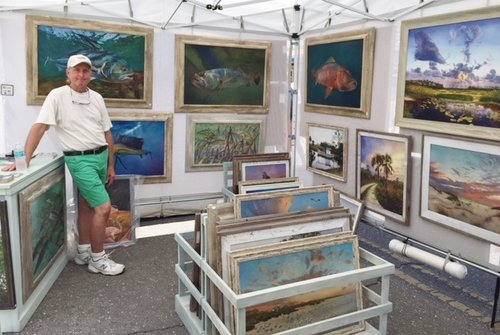by Carolyn Edlund
Want to get accepted into the best art festivals? Small details in your application can make a big difference.

Painter Keith Martin Johns exhibits at an outdoor art festival
I recently acted as a juror for a well-known, established “top 20” art festival, with hundreds of applicants vying for a limited number of booth spaces. As I reviewed each application online, it was easy to see which artists gave their best possible presentation and earned a higher score. And, I saw a number of preventable mistakes that other artists made in their application that lowered their score and hurt their chances at acceptance.
Prestigious art fairs are extremely competitive; the difference between being juried in or out might be a single point from one juror. This means that paying attention to small details really counts. It can make the difference that gets you accepted.
Submit outstanding photos
Without question, this is the most crucial element in your application. Four photos were shown on my computer screen for each artist, with an optional booth shot available. In my review, I didn’t see many poor photos from this highly-qualified pool of artists, but there were some – which stood out like a sore thumb. Glare, over or under-exposed photos, inappropriate backgrounds, and blurriness are absolutely unacceptable. Not only do they peg you as unprofessional, they do your artwork a grave disservice.
When you can make a juror say “Wow!” your chances of getting in are much higher. Are your photographs just “good enough”? Or are they knock-your-socks-off gorgeous? I saw both types in my review. Paying for professionally taken jury shots by a photographer who knows what they’re doing is worth every penny.
Make sure your photos are cohesive
In your application, you will submit a small number of images of your art. Make sure you carefully select photographs that work together to give a strong impression of your distinctive style and ability. Some applicants clearly wanted to show the “breadth” of their work, but showing different styles of paintings, or mixing disparate objects in the group gave a fractured presentation. One artist presented her metal sculpture beautifully, and in her booth shot it was apparent that she also sold jewelry. However, she wisely left the jewelry out of her jury photos, choosing to keep her portfolio tightly focused for better impact.
Choose your category with care
Many artists find that their work could fit into several different categories, and they select the one where they feel they will have the most edge over their competition. Categories like painting, photography and jewelry are often the most crowded. Jurors see a lot of the same, and with many applications, things can run together. If your work relates well to another medium or category, you may find it the best way to stand out and be noticed.
Use clear descriptions
What is your art all about? Do you use rare materials, or have a specific inspiration? Explaining an unusual technique in your written descriptions can really help jurors appreciate your work. Write each description concisely; they won’t have time to read long-winded explanations. Some artists barely write anything, leaving jurors to guess about technique or details. When putting together your portfolio shots, get a third party to view your images. Ask them, “What information would help you understand these photographs better?” and use that feedback to craft well-written explanations that enhance your application.
Your booth photo matters
When viewing a submission, a juror may be vacillating between scores, and your booth photo can tip the scale one way or another. That booth shot helps to show the scale and impact of your work. It conveys how you present your art to the public, and gives insight into the variety of work in your display. Excellent photography here is really important. Set up your booth at home if needed to get the best light, angle and presentation of your booth, making sure that it looks clean, organized and welcoming.
Despite all your best efforts, sometimes you will get rejected. Jurors aren’t perfect. They may have a bias, even though they attempt to judge each entry as fairly as possible. Simple fatigue can factor into scores, since long hours are spent viewing many applications.
You might not get accepted into that festival on your first try, but improving your application in following years can matter. Walk the show if you can, to view the quality of work on display, and better understand how you might fit into future shows. Then, take action to put together the best possible submission.



I paint in abstract acrylics.